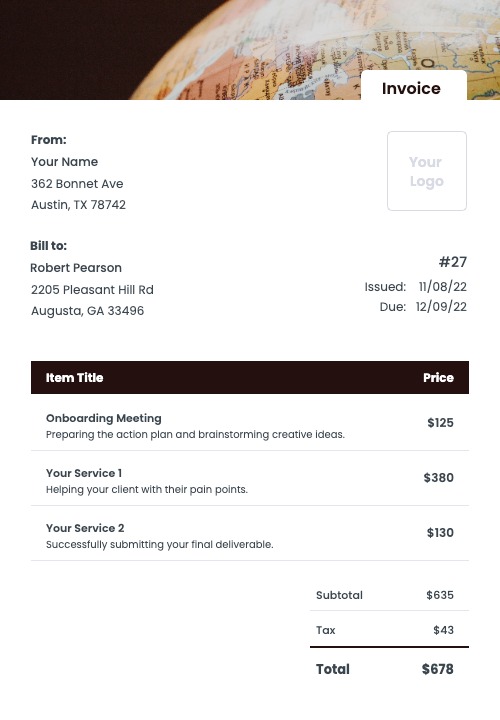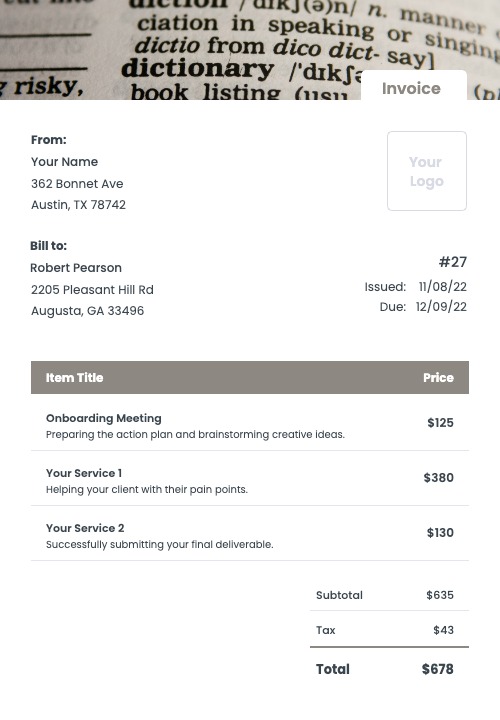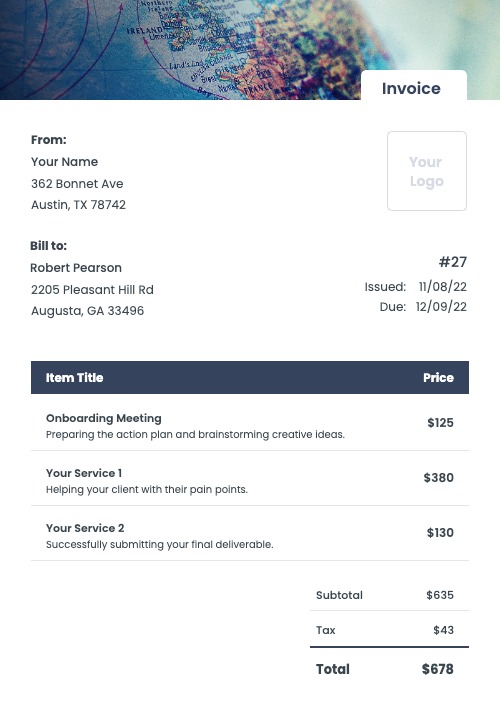Translation Invoice Templates
Worried about getting paid for your translation work? With Kosmo’s translation invoice template, you can get paid faster and focus on what you love.
With online payments and automatic late payment reminders, you’ll never have to chase a client for payment again.
Create Your Own Invoices For Free



How To Create A Translation Invoice That Gets Paid
As a translator, you provide a vital service to businesses and individuals who need to communicate across languages. Your clients rely on you to accurately translate their documents, and they expect to be charged fairly for your work.
To ensure that you are fairly compensated for your work, it is important to itemize your services in your invoices. For example, if you are translating a document from English to Spanish, your invoice might include items such as “translation”, “proofreading”, and “editing”.
If you are translating a website or app, your invoice might also include items such as “localization” and “testing”.
By itemizing your services, you can make sure that your clients understand exactly what they are paying for, and you can ensure that you are fairly compensated for your work.

Creating an invoice step by step
- Download a template
- Change the colors of the invoice
- Add your own company information
- Add your client’s details
- Add the line items
- Calculate applicable taxes and discounts
- Check the final amount
- Add your payment terms, notes and a due date
- Send the invoice to your client
- Keep track of paid and unpaid invoices
Or use Kosmo to make the process simple and fast.
Creating A Translation Invoice With Kosmo

1. Style and customize
Choose an invoice template that suits your industry and style. Next, adjust the invoice by changing the colors and by uploading your logo to match your brand.

2. Enter line items
Enter all items you’d like to bill to the client. Add a title and an optional description to provide more details regarding the work completed. Lastly, add the cost for each item.

3. Send the invoice
Choose your preferred payment method and add any terms & conditions. Hit “send” to email the invoice and receive a notification once your client has paid the invoice.
Get paid on time, every time.
Create professional invoices with Kosmo and level up your business today.
Why Should You Use A Translation Invoice Template?
If you are in the business of translating documents from one language to another, then you will need to invoice your clients for your services. A translation invoice template can save you time and help you to create professional-looking invoices.
There are a number of advantages to using a translation invoice template. First, it can help you to produce accurate invoices quickly and easily. This is important because it can help you to get paid promptly for your work. Second, a translation invoice template can help you to create invoices that look professional and that will impress your clients. This can help you to win repeat business.
Third, a translation invoice template can help you to track your income and expenses. This information can be useful in managing your business and ensuring that it is profitable.
A translation invoice template can be a valuable tool for any translator. It can help you to save time, create professional-looking invoices, track your income and expenses, and win repeat business.

Translation Invoice Requirements Checklist
- A unique invoice number.
- The payment due date.
- The date when the invoice was issued.
- Your name and/or company name and your contact information.
- Your client’s name and/or company name and contact information.
- A detailed line-by-line break down of your services and products.
- Any applicable taxes and discounts.
- The calculated total price of the invoice.
- Accepted payment methods, for example credit card, check, PayPal and others.
- Additional notes about payment terms, late fees and more.
When Is The Right Time To Send My Translation Invoice?
There is no single answer to this question since it can vary depending on the particular situation and business arrangement. However, in general, it is typically best to send a translation invoice as soon after the work is completed as possible. This way, the client can receive the invoice and make payment in a timely manner. If there is a delay in sending the invoice, it is important to communicate this to the client so that they are aware of the situation and can make appropriate arrangements.
Kosmo vs Manual Invoices
| Feature | Kosmo | Template |
|---|---|---|
| Create professionally designed invoices. | ||
| Securely send invoices to clients via email. | ||
| Get paid faster with online payments. | ||
| Automatically calculate invoice totals. | ||
| Track payments and invoices in real-time. | ||
| Receive automatic reminders for overdue invoices. | ||
| Access your invoices from anywhere in the world. | ||
| Get Started For Free |
How Invoicing Software Can Help You
Save Time
Invoicing software can help you save a lot of time. It allows you to create and send beautiful invoices quickly and easily. This means that you can spend less time on administrative tasks, and more time on your work.
Get Paid Faster
An invoicing software like Kosmo can help you get paid faster. When you send invoices electronically, you can often get paid quicker than if you had to wait for a check to arrive in the mail.
Organize Your Business
When all of your invoices are stored in one place, it is easier to keep track of what is owed and when payments are due. This can help you avoid getting paid late.
Professional Design
With invoicing software, you can often choose from a variety of templates and designs. This means that your invoices will look professional and polished. So take your pick and make your business look great.
Get paid on time, every time.
Create professional invoices with Kosmo and level up your business today.
FAQs (Frequently Asked Questions)
Who needs to use a translation invoice?
A translation invoice is a document that is typically used by businesses to request payment for translation services that have been rendered. The invoice will typically list the date that the services were provided, the name of the client, the name of the translator, the languages that were translated, the word count, the hourly rate, and the total amount due.
Translation invoices are typically used by businesses that receive translation services on a regular basis, such as companies that regularly translate marketing materials or technical documents. They can also be used by one-time clients who have received a large amount of translation services. The invoice can be sent directly to the client or to the accounting department if the client is a business.
Most translation agencies will have their own template that they use for their translation invoices. This ensures that all of the information that the client needs is included on the invoice and that the agency’s branding is prominently displayed. The invoice should be clear and concise, and it should be easy for the client to understand.
How do you bill for translation work?
There are a few different ways that you can bill for translation work. The most common way is to charge by the word. This means that you will charge a certain amount for every word that you translate. Another way to charge is by the hour. This means that you will charge a certain amount for every hour that you work on the translation. You can also charge a flat fee for the entire project. This means that you will charge one price for the entire translation, no matter how many words or hours it takes.
How to create a translation invoice?
The first step is to list out the services that were provided. This could include the number of words translated, the languages involved, the turnaround time, etc. Be as specific as possible.
The second step is to list the cost of each service. This could be a per word rate, a per hour rate, or a flat rate. Be sure to be clear and consistent with your pricing.
The third and final step is to add up the total cost and include any additional information such as discounts, payment methods, etc. Be sure to proofread the invoice before sending it off to the client.
By following these steps, you can create a professional and accurate invoice for your translation services.
How can I make my translation invoice stand out?
1. Use a bright, eye-catching color for the invoice itself. Something that will make it stand out from other white papers in a stack.
2. Make the font size for key information (like your company name, contact information, and invoice number) larger than the rest of the text. This will help it stand out and be more easily visible.
3. Use a unique or interesting layout. This will help your invoice look different from all the other rectangular shapes that are common with invoices. Perhaps use a circular layout or incorporate your company logo into the design.
4. Be sure to include all the necessary information on the invoice so that the client knows exactly what they are being charged for. This will help avoid any confusion and make it clear that you are a professional.
5. Make sure the invoice is easy to read and understand. Use simple language and clear formatting. This will help the client quickly scan the invoice and know what they need to do.
What are some tips for creating a translation invoice?
When creating an invoice for translation services, it is important to include the following information:
1. The name and contact information of your business – This should include your business name, address, phone number, and email address.
2. The name and contact information of the client – This should include the client’s name, address, phone number, and email address.
3. A description of the services provided – This should include a detailed description of the translation services provided, as well as the languages involved.
4. The date the services were provided – This should include the date the services were provided, as well as the date the invoice is being issued.
5. The total amount due – This should include the total amount due for the translation services, as well as any applicable taxes.
6. Payment terms – This should include the date by which the invoice is due, as well as any applicable late fees.
By including all of this information, you can help ensure that your invoice is clear and concise, and that your client understands exactly what they are being charged for.
What are some common mistakes to avoid when creating a translation invoice?
1. Not itemizing charges: A translation invoice should itemize all charges, including the cost of the translation itself, any additional services (such as editing or proofreading), and any taxes or other fees. This will help to ensure that the client understands the total cost of the project and can easily compare it to other quotes.
2. Not providing a breakdown of costs: In addition to itemizing all charges, it is also important to provide a breakdown of the costs. This can include a per-word rate for the translation, an hourly rate for any additional services, and a detailed explanation of any taxes or other fees. This will help the client understand exactly how the total cost is calculated.